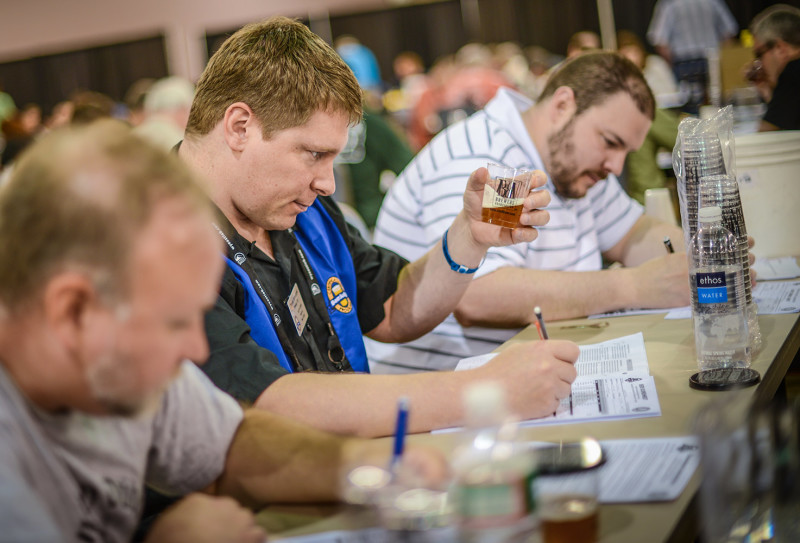
Homebrew competitions offer a chance to get honest feedback on your beer, mead, and cider.
While your friends and family might praise everything that comes out of your fermenter, homebrew competition judges are trained to evaluate beer, mead, and cider and provide unbiased feedback on a scoresheet. Take a look at the Beer Judge Certification Program (BJCP) scoresheet and the National Homebrew Competition scoresheet for examples.
Here are some tips for understanding your scoresheets and using the feedback to improve as a homebrewer.
Get the Big Picture
Before diving into the details of your scoresheet, take a look at the big picture. If entering a BJCP-sanctioned competition, your entry will have scoresheets from at least two individual beer judges along with their final “consensus” score.
Start with the consensus score. Entries are evaluated on a 50-point scale, with points awarded for aroma, appearance, flavor, mouthfeel, and overall impression. Scores can be generalized in the following ranges:
- 45–50: Word-class example of style
- 38–44: Exemplifies style well and requires minor fine tuning
- 30–37: Generally within style parameters but has some minor flaws
- 21–29: Misses the mark on style, and/or minor flaws are present
- 14–20: Off flavors and aromas or major style deficiencies
- 0–13: Major off flavors and aromas dominate
Now, take a look at the individual scoresheets. Did the judges score similarly, or did one judge seem to favor it more than the other? The judges’ total scores should be within 7 points of each other, but they may vary on how they allocated those points. For example, one judge may have detected an off flavor and deducted points in the flavor category, while the other might not have detected anything and given a higher score for that section.
This first pass of the scoresheet will help you notice areas where you excelled and areas that need improvement.
Tip: all BJCP judges are required to put their email address on scoresheets so that entrants can follow up with questions on their results.
Dig Into the Comments
Maybe you never noticed oxidation in your beer, but having the descriptor “cardboard” or “papery” helps you recognize oxidation in your beer now. Judges shouldn’t assume your brewing process, so they shouldn’t attempt to guess the exact cause of a flaw. However, with the feedback, you now have the ability to figure out the cause yourself, especially if you keep brewing notes.
[LEARN: 5 common beer off-flavors and how to fix them]
If the judges said your beer missed the style, look at the BJCP style guidelines for a commercial example. Tasting a commercial example of the style next to your beer can show you the differences more clearly than words.
Contact Judges with Questions
If you still don’t agree with the comments or have questions, remember that you might not be as sensitive to particular characteristics as the judges, and you weren’t present at the table when they judged your beer. This is blind, unbiased judging, and the judges may have stricter expectations for the style. It’s also possible they were given a bad bottle.
Give them the benefit of the doubt and look at their recommendations next time you brew. Their contact information is on each scoresheet for a reason. Send them an email with some of your questions and, more likely than not, they’ll be able to clarify. They are here to help you!

Plan for Action
Did the judges suggest something on the amount of specialty malt used or mashing temperatures? Were there suggestions on fermentation and yeast health? These things are worth trying. Remember nobody’s trying to hurt your feelings—they just want to help you make better beer!
Keeping notes of your brew day will help you decide what judge feedback to consider incorporating into your next brew day. Don’t feel like you need to incorporate all the ideas into your next brew. In fact, it’s typically better to try things one at a time to truly get an idea of its effect on your beer.
Enter More Competitions
After analyzing and implementing the suggestions from your scoresheets, re-enter your homebrew into another competition for further feedback. It takes time and effort to dial in a recipe and process, so don’t get discouraged if it takes a few competitions to see noticeable improvement.
[FIND : BJCP-sanctioned homebrew competitions]
Brewing, getting unbiased feedback, and using that feedback to improve are the best ways to become a brewer of great beer at home!
* * *
John Moorhead is the American Homebrewers Association Competition Coordinator and National Homebrew Competition Director. If John isn’t tasting, brewing, or talking beer, you might find him traveling, biking, fishing, skiing, or hiking – or cooking Thai food while listening to his records.




Share Post